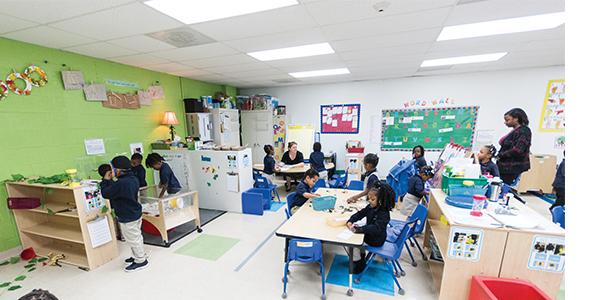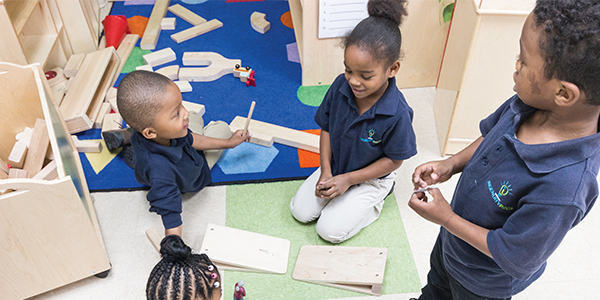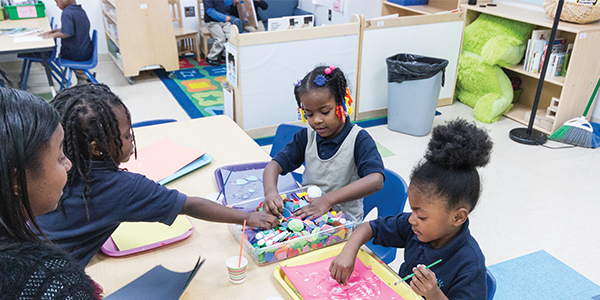From Circle Time to Small Groups: Meeting Children’s Needs

You are here
Whether you’ve been teaching for a few months or many years, you’ve probably faced some challenges with circle time. I know I have! Asking a large group of preschoolers to sit down, keep their hands to themselves, listen to me for an extended amount of time, and then answer questions about what they have learned has not resulted in productive teaching or learning. I’ve tried singing songs, reviewing the weather, reading and discussing stories, and other circle time staples. After 22 years of teaching, I’ve concluded that it is very hard to make circle time successful for each child.
Instead of trying to get the children to adapt to circle time, try adapting your approach to meet their needs. To start thinking more flexibly about what circle time could be, here are a few approaches that work well:
- Welcome children to the classroom. Circle time is the perfect place to establish a classroom community as teachers and children take time to greet one another. This can be done through a welcome song or an activity in which the children track who came to school each day, like with a classroom graph.
- Introduce new materials. Circle time is an excellent opportunity to make sure each child understands how to use new materials added to the room. This way, all children have received the same directions on how to use the material safely and successfully.
- Review social rules. Circle time is also an appropriate setting for reviewing classroom rules and social customs, like how to treat classmates. You will still have to offer many children individual reminders about how to follow the classroom rules; however, introducing these concepts at circle time helps children understand the rules of the community and how to be a part of the social environment.
What these three uses of circle time have in common is that they can be done fairly quickly. When you bring the children together, do just one of these so your circle time takes 5 or 10 minutes at most. Before the children get the wiggles, they are off to their next activity.

Smaller groups, deeper learning
So how do you bring the classroom together for community building and collaborative learning without traditional circle time? I’ve found that small groups work much better, offering opportunities for deeper learning in the early childhood classroom.
Small groups with two to four children at one time can have enormous benefits:
- Differentiated learning: Children come to the classroom with different strengths, interests, experiences, and needs. Small group learning allows you to meet children where they are, introducing ideas and activities that are just the right level of challenging for each child.
- Open-ended conversations: Small group learning provides opportunities for children to ask many different questions and for you to answer or help children find answers. Back and forth conversations are much easier to foster in small groups, and they allow you to ask questions based on individual children’s imaginations and understandings.
- Child-led activities: In small group settings, you are able to customize activities and follow the children’s interests. You may demonstrate the same activity at the sand table for three or four groups of children, but the conversations in each group will probably go in very different directions. One small group may lead to discussions about dinosaur fossils while another may discuss a beach vacation!

Give small groups a try
Although many teachers see the benefits of small group learning, it can initially be confusing to implement. In the beginning, I worried about what the rest of the class would do while I was leading a small group. One successful approach can be meeting with each small group while the other children in the classroom are participating in free-choice activities. Here are several strategies that I have used to improve overall classroom management while spending time with small groups:
- Be prepared. One simple way to reduce problematic behaviors in the classroom is to make sure all materials are prepared in advance so that children do not have to wait for you. Try to be efficient, spending less time away from the group as a whole and therefore keeping the small group more engaged.
- Keep an eye on the rest of the class. Even though you will be primarily focused on a small group of children, it is essential to continue to demonstrate classroom awareness. Choose a location for the small group lesson that offers a view of the entire classroom. Being able to see and hear every child is crucial.
- Practice coteacher communication. Teachers and assistant teachers must communicate about what small group time will look like. If you and your colleagues plan to have several small group lessons during the course of the morning, also discuss who will lead each lesson and what the other teachers will be doing during that time. If one teacher is sitting down leading a small group, then the other teacher will be responsible for the flow of the classroom and should move throughout the room to ensure safety. It’s important to decide on these roles prior to beginning the lessons.
If you try having a little less circle time and a little more small group time, I think you’ll find more opportunities to connect with each child as an individual and more success in developing children’s knowledge and skills.
Photographs: © NAEYC
Sarah Taylor Vanover, EdD, is the director of the Division of Child Care in the Commonwealth of Kentucky and has worked in the field of early childhood education for 22 years.